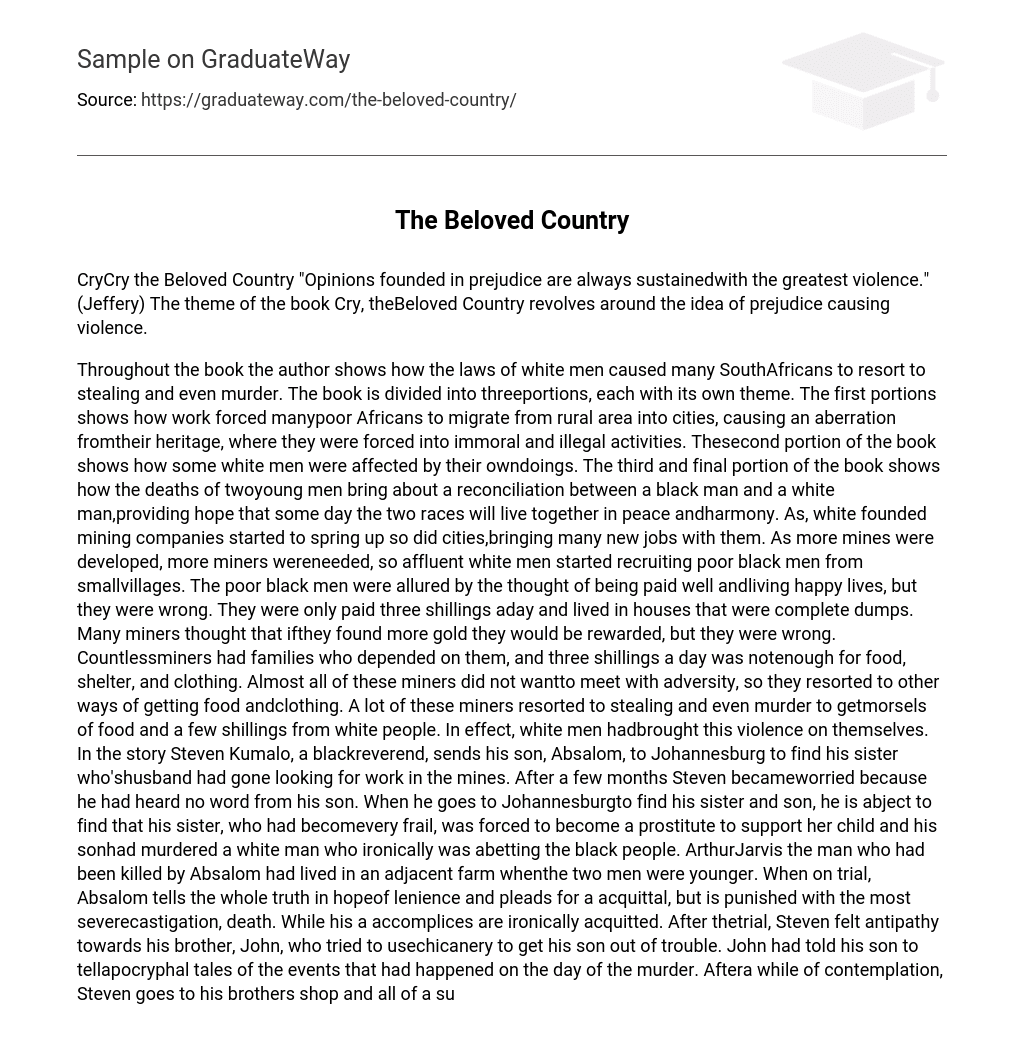According to Jeffery, opinions rooted in prejudice are always upheld with the utmost violence. The book Cry, the Beloved Country centers on the theme of prejudice leading to violence.
The book delves into the impact of laws imposed by white men on South Africans, resulting in theft and murder. It is divided into three parts, each with its own theme. The first part explores how impoverished Africans were driven to engage in immoral and illegal activities in cities due to the demand for labor. The second part emphasizes the consequences faced by specific white men as a result of their actions. Lastly, the third part demonstrates reconciliation between a black man and a white man following the deaths of two young men, offering hope for peaceful coexistence between races.
The establishment of cities and job opportunities was facilitated by the rise of white-founded mining companies. In order to meet the growing labor demand, wealthy white men recruited poor black men from small villages. These black men were enticed by promises of good pay and improved lives but soon discovered they had been deceived. They received meager wages of only three shillings per day and resided in dilapidated houses.
With families depending on them, these miners found that three shillings fell short in covering their basic needs such as food, shelter, and clothing. Faced with adversity, they resorted to alternative methods for sustenance and attire. Many turned to theft or even murder as means to obtain food and money from white individuals.Essentially, the violence in the story was brought upon the white men themselves. A black reverend named Steven Kumalo sends his son, Absalom, to Johannesburg to find his sister whose husband had gone to work in the mines. Due to no communication from his son for months, Steven travels to Johannesburg looking for his sister and son. Unfortunately, he discovers that his weak and frail sister was forced into prostitution to support her child, and his son had killed a white man who paradoxically helped black people. The man killed by Absalom, Arthur Jarvis, used to live on a nearby farm when they were younger. During the trial, Absalom honestly confesses hoping for leniency but receives the harshest punishment: death. Ironically, his partners in crime are acquitted. After the trial, Steven holds animosity towards his brother John who tried deceivingly helping Absalom with fabricated stories about the murder day’s events. After contemplating for some time, Steven unexpectedly confronts John at his shop expressing immense bitterness towards him. It is important to acknowledge that although blacks suffered more than whites; whites also faced hardships as Jarvis mourns the loss of his son ArthurDespite their past differences, both fathers now have a shared understanding of the pain caused by their sons’ deaths. Their meeting on the sacred mountain enables them to find comfort and compassion in one another’s grief. This tragedy has taught them that love and forgiveness can surpass racial boundaries, causing them to reevaluate their previous convictions. Despite carrying immense sorrow, they strive for reconciliation and solidarity, undergoing a profound change as a result of an unimaginable loss.
Jarvis provides financial support to Steven for the construction of a new church for his village. Steven agrees to this condition, but on the condition that he includes a stone with Arthur’s name on it. Some days prior to this, Steven had prayed for rain due to a severe drought in South Africa. As he was leaving for the mountain, heavy rain poured down, symbolizing hope for eventual peaceful coexistence between the two races. Alan Paton’s narration vividly depicted the challenges and turmoil faced by many Africans. Through his storytelling, Paton immersed the reader in the experiences of the character he was discussing. Paton demonstrated that something positive can emerge from adversity. The younger generation showcased a path towards a brighter future.





